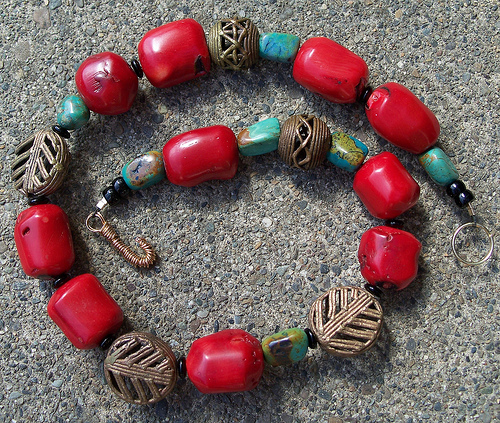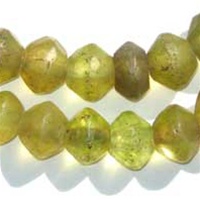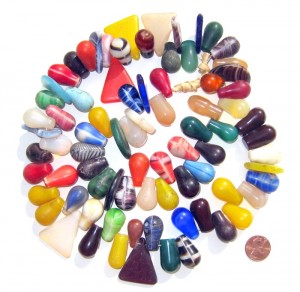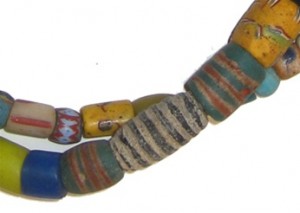Padre Beads – Relics of the Ch’ing Dynasty
Today, China has the monopoly on 21st century bead production. But it wasn't always so. Prior to 1912, the country had little in the way of a bead industry to speak of; its economy largely dominated by farming and agricultural industries. It wasn't until the 17th Century – the beginning of the Quing (or Ch'ing) Dynasty - that glass-makers began to realize the true economic potential of glass bead-making. Up until that point, only a handful of artisans were producing glass for anything other than commercial sale.
Competition among senior members of the royal court was rife in the 17th Century. Both men and women strived to outrank one another in terms of style and extravagant displays of wealth, just so they would be accepted by those in the upper echelons of society. Like jewels and gold, heavy embroidered fabrics were considered trademarks of wealth and aristocracy. Those that couldn't afford expensive diamonds commissioned glass-makers to produce small, wound glass beads known as “Peking beads” to embroider their gowns, starting a trend that would continue for the next 300 years.
As trade networks developed between Europe, America and Asia, the Chinese began to recognize the potential of glass beads for economic gain. They began trading glass beads with tribes across Asia in exchange for exotic fruits, spices, tea and animal pelts; eventually expanding their trade networks to include parts of North America. Realizing the value of glass beads to indigenous tribes, Spanish merchants began exporting beads from China for their own gain. Spanish padres too saw the potential of these small glass beads, and began using them to convert African tribes during Christian missions in Africa – hence the name “Padre Beads!”
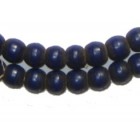
Old Navy Blue Padre Beads
The Cultural Significance of Coral Trade Beads in Benin
Coral beads have a unique symbolism to many tribes in Africa, yet few have adopted these beads into their culture quite as literally as the Bini people of Benin. They are customarily worn for both marriage and funeral rites, but also as an indication of social standing and power among clan chiefs.
There are two main types of coral bead identifiable in Benin culture: Ivie and Ekan. Ivie is considered the more precious of the two, and can usually be found in scarlet, rose and medium pink hues. Ekan is more stone-like in appearance with long threads of dark color interspersed with strips of steel gray. The former is considered far more valuable by Edo chiefs owing to its rarity, and also due to the fact it was allegedly stolen from the goddess of the sea by King Oba Ewuare in the 15th Century. It's rather more likely that both types of coral were introduced to Benin by European traders around this period, as the city was, back then, a crossroads for trade between Europe and Africa.
For centuries, the Oba (traditional rulers) of Benin have had strict rules governing the wearing of Ivie and Ekan in Bini culture. Certain shapes are considered rare and valuable, and can only be worn by clan chiefs and spiritual leaders. Historical records show that some chiefs who brought shame upon their clans, or fell out of favor with the Oba, were prohibited by Royal Edict from wearing coral beads completely. There is a well known story in Benin which tells how, in the 1940's, a ruler by the name of Oba Akenzua II seized the ceremonial beaded head-wear and coral beads of Chief Okorotun for his disloyalty to the royal family. Allegedly, the ceremonial garb was sent to his successor – an indication he was to become a chief, by order of the Oba. Had he refused, it would have been considered a treason of sorts. The chief would have become an outcast, and possibly even exiled for his refusal. What a price to pay for refusing a strand of beads!
How Exotic Cornaline d’Aleppo (White Heart) Beads Got Their Name
Do you ever wonder how certain African trade beads come to get their names? The origins of most African trade beads can usually be determined by their name. For example, Dogon Beads are so called because of their popularity among the Dogon tribe of Bandiagara, Mali. But some, as I've recently come to find out, are a little more misleading.
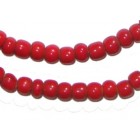
Red White Heart Beads
Cornaline d'Aleppo (commonly known as "White Heart Beads", or "Hudson Bay Beads" in America) were a popular type of wound and drawn trade bead produced between 1805 and the early 1900s in Venice, Italy. Unlike the more elaborate Millefiori Beads and Chevrons, Cornaline d'Aleppo are rather plainer in appearance, comprising just two layers of different colors. The core is usually white or off-yellow, while the outer layer (which wraps the core) is thicker, and ranges in color from burnt yellow to ruby red. A small quantity were also produced in varying shades of blue around the turn of the 20th Century, however, the most coveted were a seductive shade of dark ruby red. According to historical data, the brilliant red of Cornaline d'Aleppo Beads was the result of adding gold oxide to pink or violet glass.
So, how did they get their name? No-one can say with any great certainty why these Venetian Trade Beads came to have such an exotic name, although, it is thought that French-speaking tribespeople in Mali may have had something to do with it. The word "cornaline" is French for carnelian, a type of agate often used as currency among inter-trading tribes in Africa. "Aleppo" on the other hand, is the name of a small town in Syria. Some suggest the reference to Aleppo was inspired by the fact that it was once an important trading post between Africa and Asia. Nomadic African tribespeople would pass through the city to stock up on supplies, exchanging carnelian beads for essentials such as furs, tools and food. I prefer to believe the name derives from the magical striped stones of Aleppo, famous throughout Africa and Asia for their healing properties.
King Beads: The Mark of African Royalty
"King Beads", so named because of their popularity among tribal leaders during the trade era, are a type of marvered glass bead made in Murano, Italy, during the 19th Century. The earliest known examples of King Beads date back to the mid 1800s, examples of which can still be seen among the Moses Lewin Levin sample bead card collections held at the British Museum, London.
Characterised by their distinctive bicone shape and bold stripes, King Beads were typically larger than striped Chevrons, and were solely intended for use as a trade currency between merchants and African tribes. But, although Venetian King Beads run the gamut of color variations, the most common are green with yellow, red and black stripes. It is thought that such combinations were produced to enhance the appeal of the beads in Africa. Certain tribes, such as the Krobo of Ghana, are renowned for their use of colored beads as a medium of communication, and consider some combinations to be more desirable than others.
Legend has it that the size and specific colors of King Beads was inherent to their popularity among tribal chiefs in the 19th Century. The Anlo Ewe of Benin and Togo regarded these larger beads as being superior to other types of trade beads, and quickly adopted them as wearable symbols of status. Yellow King Beads became central to the Dipo initiation ceremonies in Krobo culture, since the color is associated with coming of age and future prosperity. Interestingly, a number of archeological excavations in Ghana have revealed that some royals were even buried with their King Beads – possibly to aid their prosperity in the afterlife!
Mythical or Medicinal? The Alleged Properties of Skunk Trade Beads
Skunk Beads, (often referred to as 'Eye Beads' due to the intricacy of some
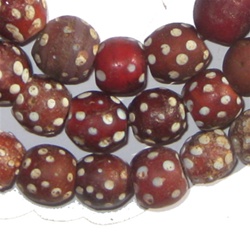
Antique Skunk Eye Beads, Red.
spot designs) are a product of 18th Century Venetian manufacturing. Created using the wound, or drawn glass production method; Skunk Beads represent one of the earliest forms of 'lampwork', a process which involves the addition of small glass globules to a set surface, giving the 3-D raised effect.
Collectors of Venetian trade beads are often in the dark about why Skunk Beads are so named. It is thought the name actually derives from the similarities of the bead design to the coat of the North and Central American Skunk species 'spilogale'. Unlike the native Striped Skunk, the spotted variety are considerably smaller, often with very intricately detailed coats.
Of the many hues of Skunk Beads that have been produced, purists believe that only the black and white variety are true Skunk Beads. The highly collectible red variant were originally known as 'Cornaline d'Aleppo', so named after the Aleppo Stone ('Eye Stone') thought to originate within Syria.
It is possibly from the mythical properties of the Aleppo Stone, that the powers of Skunk Beads for holistic healing have evolved. The agate Aleppo Stone is alleged to be a cure for a prominent Mediterranean skin disease known as the 'Aleppo Boil' or 'Biskara Boil'. The skin condition usually affects the face, and eventually becomes a pus-filled ulcer if left untreated. Carriage or wearing of the spotted Aleppo Stone is thought to rid carriers of the disease, and act as prevention from it.
So too, Skunk Beads are attributed with similar healing powers, despite being made from glass. This could stem from the beliefs of certain African tribes that spirits are omni-present, particularly within beads that are 'of the Earth'. Glass is typically produced from silica and sand, along with several other natural compounds, therefore glass beads are considered 'of the Earth'. Whether or not Venetian Skunk Beads possess holistic benefits; they are still considered some of the most beautiful and collectible of all African trade beads!
Vaseline Trade Beads: A Radioactive Discovery?
We are proud to share with you the most comprehensive background on those beautiful beads known as Vaseline trade beads.
The 'radioactive era' as some refer to it was a period between the early
1900's, up to 1930 when a number of distinctive discoveries and advancements influenced an obsession with all things 'radioactive'. It was German chemist Martin Heinrich Klaproth who first discovered Uranium in 1789, however later revelations from French physicist Antoine Becquerel in 1896 proved that Klaproth had not isolated the metallic element - which we now know influences color under ultraviolet light.
Marie and Pierre Curie's work superseded these scientific announcements with the pioneering discovery of Radium in 1898. Interestingly, Marie Curie's work which extended to developing x-ray technology and radiography, won her two Nobel Prize Awards. Her work assisted in helping the treatment of soldiers during World War I, which is probably why she was also the first prize winner to be award two consecutive prizes, for two different types of work - chemistry and physics.
The trend for radioactive chemicals being used for decorative and everyday objects began around 1905. Everything from blown glass vases, to clock-faces, earthenware, pottery and Vaseline Beads were being made with the fluorescing properties of Uranium. Uranium influences an intense yellow-green, or violent green depending upon the kind of light it is subjected to, and appears to glow immensely in ultraviolet light.
Prior to the official discovery of Uranium as an isolated element, the compound was already being used (it is thought) within the production of glass trade beads. Several collections of faceted Vaseline Beads have been discovered, and are thought to date back to the 1830's - all feature the yellow-green characteristics attributed to the Vaseline Beads of the early 1900's. Vaseline Beads are often regarded as a product of Africa, however were first produced within Bohemia - now Czechoslovakia.
The fascination with radioactivity between 1905 and 1915 prompted a period of mass production for Vaseline Trade Beads, and not just within Bohemia. Several other countries, including England and Italy were also caught up with the fascinating properties Uranium salts influenced. Interestingly, it was only a concentration of 1-2% Uranium salts to a glass mold that would offset the chemical reaction that produces the green-yellow aesthetic.
Authentic Vaseline Beads produced around the late 1800's/ early 1900's are distinct due to their shape. Rondelles and discs were by far the most common shapes, however it is not unusual to uncover some with cut facets. Later replicas of Vaseline Beads were produced without Uranium (since later science also uncovered the possible harmful effects of radiation), and can be found in multiple hues. The Uranium was replaced with oxides or dyes during the molding process, and manual manipulation used to replicate the fluorescing qualities of Uranium.
A Buyers Guide To Mali Trade Beads – What To Look For, What To Avoid
Speckled, marbled, bulbous or triangular. Regardless of their shape, color, size or opalescence, there's no denying that Mali Wedding Beads are some of the most spectacular of African origin. From the simple way they refract and reflect light, to the way they hang when strung as a 'bouquet' for a focal necklace center-piece, Mali Wedding Beads exude a beauty and mystique that often belies their archaic history.
With the surge in popularity of auction sites as a primary means of retail, there has also been a ten-fold increase in the quantity of African beads being sold through these mediums. Mali Wedding Beads, along with Venetian Trade Beads, and African Chevrons comprise some of the most sought-after African bead variants, yet shopping for the 'real deal' has become a lot more challenging.
Why is it so difficult to source genuine Mali Beads?
The primary factor that has led to many questioning the authenticity of Mali Beads (that are not sold through accredited wholesalers and dealers), is the production of replicas and reproductions by both Middle Eastern and Western entities. Mali Wedding Beads can often command quite high prices, particularly if sufficient evidence accompanies them to prove they are of pre-1900 origin, and modern techniques are such, that it can be almost impossible to distinguish a reproduction from a true authentic bead.
Signs of Authenticity
If you've been an avid collector of African trade beads for a while, you will more than likely be familiar with the quality, weight and appearance of such old beads. African trade beads tend to have survived over a Century of exchange, travel, wear and tear to end up with the supplier selling them onto you. As a result, their general appearance, texture, and even structure may have suffered from such long life - characteristics loved by the people that collect them, and often what influences their high value in some cases. Other things to look for, or beware of include:
- Obvious Seams: It's generally very rare to come across Mali Wedding Beads that bear a pronounced or obvious seam. Part of their allure is the inherently smooth, glossy finish. If the Mali Beads you're looking at appear to have a prominent ridge from the bulb to the tip, chances are it is a modern reproduction.
- Threading Holes: Sounds daft doesn't it. Surely any bead should bear a threading hole, given their primary purpose is decorative. You'd be surprised at just how many 'replicas' are sold on a daily basis that do not feature this trademark Mali Bead characteristic! Old Mali Beads always bear a vertical threading hole at the 'head' of the bead (the part narrower than the bulb.) Modern variants are produced with a metal pendant fish-eye attachment or something similar, so that the bead can be used as a single pendant.
- Quantity: Authentic African trade beads are always sold by the string upon which they were sourced, by wholesalers committed to protecting the quality and authenticity of such beads. Such beads are often discovered in this state, and will have remained like this since they were first strung a hundred or so years ago. Sellers who break down African trade beads are usually those selling them on auction sites, out to make a quick profit with little regard for the authenticity, and historic relevance of keeping beads together.
- Number in Stock: Authentic trade bead retailers will usually be happy to inform you of the likelihood of certain beads coming back into stock, as well as their sources of stock. An extremely high number of 'bead strings' being sold through an independent dealer (particularly through marketplaces or auction sites) is indicative that they may not be genuine. Accredited dealers rarely have surplus. In fact, they tend to sell out of their authentic wares within days of it's arrival. Due to sourcing direct from Africa, it may also be a wait before such stock reappears upon their store catalog.
Other than the above, you should expect real Mali Wedding Beads to feature signs of wear and age. They may appear dirty, pitted, scratched, worn and even sun-bleached in some cases - all characteristics that indicate age, wear and extensive travel from one person to another. When your Mali Beads arrive, don't be disappointed to find them in such condition - it's part and parcel of their history, genuine character, and most importantly authenticity!
Zulu Beads – The Hidden Love Letters of Africa
Bead adornment has long been used for communicative purposes, although it is largely the tribes of Southern Africa whom are renowned for the complexities of this visual communication method. During the thriving merchant era, certain types of trade beads (notably Chevrons) were highly sought after due to their rarity, or intricacy, and would therefore be worn by elders, Royalty and aristocracy to signify wealth, status and governing power.
But African trade beads weren't the only variant that bore significance as a correspondence tool. Zululand, in the heart of South Africa, is also known for a complex 'language', that uses both Zulu beads, and simple symbols such as the triangle, to convey non-verbal messages. The most common use for this communication method, is for love letters, in a society where it was once frowned upon for women to initiate the courting with men.
The Zulu bead language is built around the geometric triangle - each point bearing a significance to marital status, as does the positioning. Typically, if the point faces Southward, this denotes an unmarried woman, whereas if the apex points North, this signifies an unmarried man. Variants on both the orientation of the triangle, it's attachment to another, and the color of beads it is depicted against, all have an influence upon the message conveyed. Seven main bead colors tend to be used within the bead 'language', and although they all have primary meanings (i.e black connoting sadness, dismay and death); secondary definitions and messages can be created, as a result of the context in which Zulu beads are arranged. Different hues also influence context.
The most common colors used within the Zulu code are: green, which can symbolize contentment, yet also convey envy; blue which signifies longevity and faithfulness; red is strength of emotion, so can dictate love or anger; white for purity, honesty and neutrality of spirit; and finally pink, which added emphasis to a promise, and suggestion of fertility.
With such a beautifully simple language at their fingertips, both Zulu men and women found an avenue by which they could discuss and relay affairs of the heart, without doing so in public. The creative arrangement of Zulu beads allowed for more intricate expression, giving birth to several now well known Zulu love poems. One of these is "iNcwadi" ("I-en-che-wadi"), describing black as a depression due to a lover's absence, and green as the "springing of shoots", likened to the birth of love.
